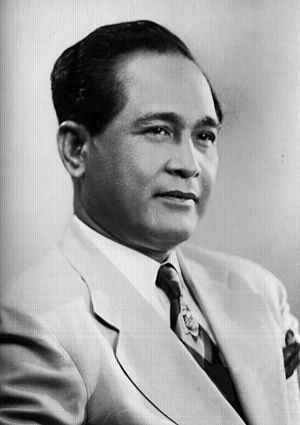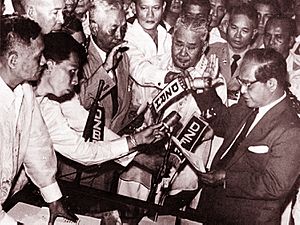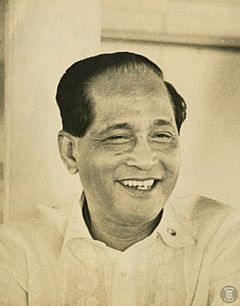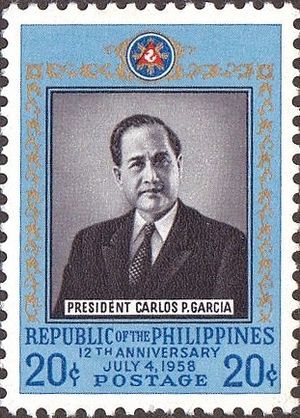Carlos P. Garcia facts for kids
Quick facts for kids
Carlos P. Garcia
KR DMN
|
|
|---|---|
 |
|
| 8th President of the Philippines | |
| In office March 18, 1957 – December 30, 1961 |
|
| Vice President | None (March 18 – December 30, 1957) Diosdado Macapagal (1957–1961) |
| Preceded by | Ramon Magsaysay |
| Succeeded by | Diosdado Macapagal |
| 1st President of the 1971 Philippine Constitutional Convention | |
| In office June 1, 1971 – June 14, 1971 |
|
| President | Ferdinand Marcos |
| Succeeded by | Diosdado Macapagal |
| 4th Vice President of the Philippines | |
| In office December 30, 1953 – March 18, 1957 |
|
| President | Ramon Magsaysay |
| Preceded by | Fernando Lopez |
| Succeeded by | Diosdado Macapagal |
| Secretary of Foreign Affairs | |
| In office December 30, 1953 – August 22, 1957 |
|
| President | Ramon Magsaysay (1953–1957) Himself (1957) |
| Preceded by | Joaquín Miguel Elizalde |
| Succeeded by | Felixberto Serrano |
| Senator of the Philippines | |
| In office May 25, 1945 – December 30, 1953 |
|
| Governor of Bohol | |
| In office December 30, 1933 – December 30, 1941 |
|
| Preceded by | Celestino B. Gallares |
| Succeeded by | Agapito Y. Hontanosas Sr. |
| Member of the Philippine House of Representatives from Bohol's 3rd district | |
| In office 1925–1931 |
|
| Preceded by | Teodoro Abueva |
| Succeeded by | Filomeno Orbeta Caseñas |
| Personal details | |
| Born |
Carlos Polestico Garcia
November 4, 1896 Talibon, Bohol, Captaincy General of the Philippines |
| Died | June 14, 1971 (aged 74) Quezon City, Philippines |
| Resting place | Libingan ng mga Bayani, Taguig, Metro Manila, Philippines |
| Political party | Nacionalista |
| Spouse |
Leonila Dimataga
(m. 1933) |
| Children | Linda Garcia-Campos |
| Alma mater | Silliman University Philippine Law School (National University) |
| Profession | Lawyer |
| Signature | |
Carlos Polestico Garcia (November 4, 1896 – June 14, 1971) was an important Filipino leader. He was a teacher, poet, lawyer, and public official. He became the eighth President of the Philippines.
Garcia started his political journey as a representative for Bohol in the House of Representatives of the Philippines. Later, he served as a senator from 1945 to 1953. In 1953, he became the Vice President alongside Ramon Magsaysay. After President Magsaysay's sudden death in 1957, Garcia became president. He then won a full term in the 1957 election.
Contents
Early Life and Education
Carlos P. Garcia was born in Talibon, Bohol, Philippines on November 4, 1896. His parents were Policronio Garcia and Ambrosia Polestico. Both were from Bangued, Abra.
Garcia grew up in a political family. His father was a municipal mayor for four terms. Carlos went to primary school in Talibon and high school in Cebu Provincial High School. He was always at the top of his class. He studied at Silliman University and then at the Philippine Law School. He earned his law degree in 1923. He was one of the top ten students in the bar examination that year.
Instead of practicing law right away, he taught at Bohol Provincial High School for two years. He was known for his poetry in Bohol. People called him the "Prince of Visayan Poets" and the "Bard from Bohol."
Political Career
Garcia started his political career in 1925. He won a big victory to become a representative for the third district of Bohol. He was re-elected in 1928 and served until 1931.
In 1933, he was elected Governor of Bohol. He served until 1941. He then successfully ran for Senate. However, he could not serve right away because of the Japanese occupation of the Philippines during World War II. He took office when the Congress met again in 1945 after the war ended. As a senator, he was chosen as the Senate majority floor leader. The news often called him one of the best senators.
World War II
During World War II, Garcia refused to work with the Japanese. He did not surrender even when they put a price on his head. Instead, he joined the guerrilla movement. He served as an adviser to the free government organized in Bohol.
Vice-Presidency

Garcia was the running mate of Ramon Magsaysay in the 1953 presidential election. Both of them won. President Magsaysay then made Garcia the Secretary of Foreign Affairs. For four years, Garcia served as both Vice President and Secretary of Foreign Affairs.
As Secretary of Foreign Affairs, he worked to end the state of war between Japan and the Philippines. This led to an agreement in April 1954. He also spoke at the Geneva Conference of 1954. There, he defended the U.S. policy in Asia and spoke against communism. Garcia also led the Southeast Asian Security Conference in Manila in September 1954. This meeting helped create the Southeast Asia Treaty Organization (SEATO).
Presidency
| Population | |
|---|---|
| 1957 |  22.68 million 22.68 million |
| Gross Domestic Product (1985 constant prices) | |
| 1957 | |
| 1961 | |
| Growth rate, 1957-61 | 4.6% |
| Per capita income (1985 constant prices) | |
| 1957 | |
| 1961 | |
| Total exports | |
| 1957 | |
| 1961 | |
| Exchange rates | |
| 1 US US$ = Php 2.64 1 Php = US US$ 0.38 |
|
| Sources: Philippine Presidency Project Malaya, Jonathan; Eduardo Malaya. So Help Us God... The Inaugurals of the Presidents of the Philippines. Anvil Publishing, Inc.. |
|
How Carlos P. Garcia Became President
President Magsaysay died suddenly on March 17, 1957. At that time, Vice President Garcia was in Australia for a conference. He was told about the sad news right away. Vice President Garcia flew back to Manila. When he arrived, he went straight to Malacañang Palace to become president. Chief Justice Ricardo Paras gave him the oath of office on March 18, 1957. President Garcia's first actions were to declare a time of national mourning. He also led the funeral ceremonies for Magsaysay.
The 1957 Presidential Election
President Garcia won a full term as president in the national elections on November 12, 1957. He was the candidate for the Nacionalista Party. He won with about 2.07 million votes. This was 41% of all the votes. He beat his closest opponent, José Yulo. His running mate, Jose Laurel Jr., lost to Diosdado Macapagal. This was the first time a president and vice-president were elected from different political parties.
Fighting Against Communism
After many discussions, the Congress of the Philippines passed a law. This law made the Communist Party of the Philippines illegal. President Garcia signed this bill into law on June 19, 1957. It was called Republic Act No. 1700, or the Anti-Subversion Act. This law was later changed and then repealed in 1992.
Filipino First Policy
Garcia was well-known for his Filipino First Policy. This policy strongly supported Filipino business people. It gave them an advantage over foreign investors. He also made changes in retail trade. These changes greatly affected Chinese business people in the country.
Austerity Program
The country faced difficult economic times. So, Garcia started what was called "The Austerity Program." His government focused on saving money and promoting a strong nationalist policy. On March 3, 1960, he said that the government needed full economic freedom. He added that foreign businesses, especially American ones, would no longer control the national economy. He promised to remove "foreign control in business, trade, commerce and industry." Garcia also helped bring back Filipino cultural arts.
The main goals of the Austerity Program were:
- To control exports and imports more strictly.
- To reduce government imports to only essential items.
- To buy less rice from other countries.
- To improve the local transportation system to save on gasoline and spare parts.
- To change the tax system so everyone paid fairly.
- To grow more food in the country.
People generally liked this program. They believed it would help solve the country's problems.
Bohlen–Serrano Agreement
During his time as president, Garcia worked on the Bohlen–Serrano Agreement. This agreement shortened the lease for American military bases in the Philippines. It changed from 99 years to 25 years. It could be renewed every five years.
Creating the International Rice Research Institute
President Garcia, with the help of Secretary Juan G. Rodriguez, invited the Ford Foundation and the Rockefeller Foundation. He asked them to create a rice research institute in Los Baños, Laguna. This led to the establishment of the International Rice Research Institute in 1960.
Republic Cultural Award
Besides his laws and programs, the Garcia administration also focused on bringing back Filipino culture. To do this, the Republic Cultural Award was created. Even today, this award is given to Filipino artists, scientists, historians, and writers.
The 1961 Presidential Election
At the end of his first full term, he ran for re-election in the presidential elections of November 14, 1961. However, he was defeated by Vice President Diosdado Macapagal. Macapagal belonged to the rival Liberal Party.
Post-Presidency and Death
After losing his re-election bid, Garcia went back to Tagbilaran to live as a private citizen.
On June 1, 1971, Garcia was chosen as a delegate for the 1971 Constitutional Convention. The delegates then elected him as president of the convention. However, on June 14, 1971, Garcia died from a heart attack at his home in Quezon City. He was succeeded as president of the convention by his former vice-president, Diosdado Macapagal.
Garcia was the first non-religious person to have his body displayed in Manila Cathedral. This honor was usually only for Archbishops of Manila. He was also the first president to be buried at the Libingan ng mga Bayani (Cemetery of Heroes).
Family
On May 24, 1933, Carlos P. Garcia married Leonila Dimataga. They had one daughter, Linda Garcia-Campos.
Honors
National Honors
Foreign Honors
 Malaya:
Malaya:
 Spain:
Spain:
 Collar of the Order of Civil Merit (October 1, 1957)
Collar of the Order of Civil Merit (October 1, 1957)
 South Vietnam:
South Vietnam:
Images for kids
See also
 In Spanish: Carlos P. García para niños
In Spanish: Carlos P. García para niños











